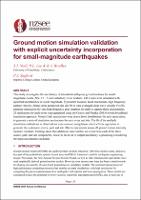| dc.description.abstract | This study investigates the uncertainty of simulated earthquake ground motions for small-magnitude events (Mw 3.5 – 5) in Canterbury, New Zealand. 148 events were simulated with specified uncertainties in: event magnitude, hypocentre location, focal mechanism, high frequency rupture velocity, Brune stress parameter, the site 30-m time-averaged shear wave velocity (Vs30), anelastic attenuation (Q) and high frequency path duration. In order to capture these uncertainties, 25 realisations for each event were generated using the Graves and Pitarka (2015) hybrid broadband simulation approach. Monte-Carlo realisations were drawn from distributions for each uncertainty, to generate a suite of simulation realisations for each event and site. The fit of the multiple simulation realisations to observations were assessed using linear mixed effects regression to generate the systematic source, path and site effects components across all ground motion intensity measure residuals. Findings show that additional uncertainties are required in each of the three source, path, and site components, however the level of output uncertainty is promising considering the input uncertainties included. | |

